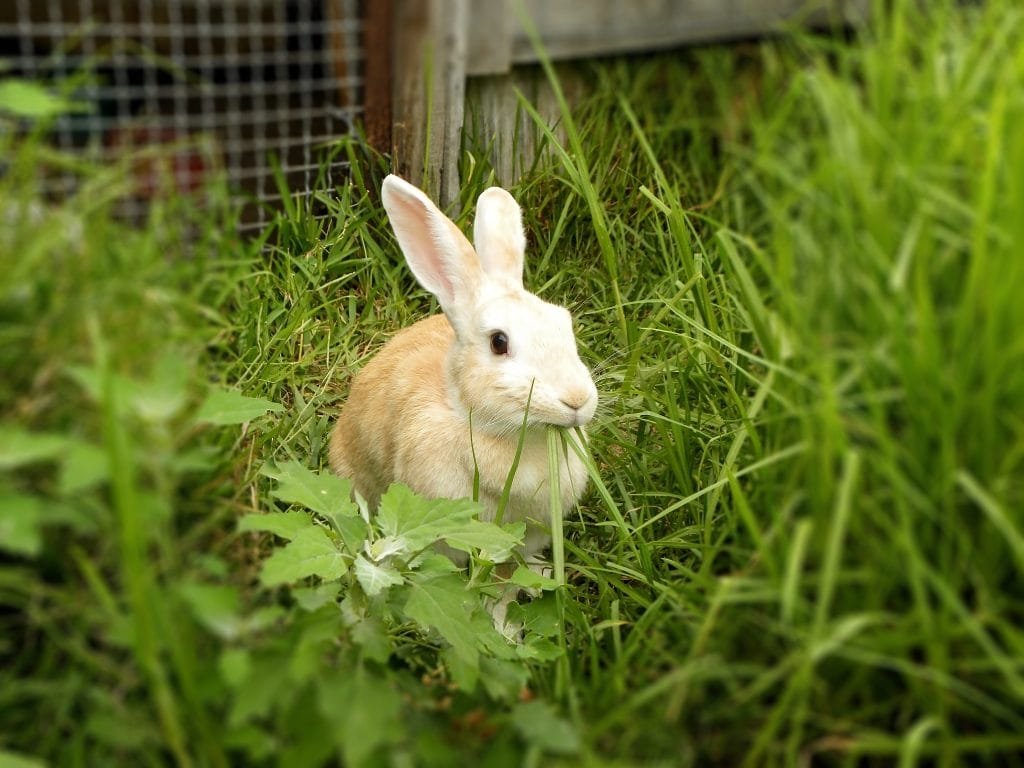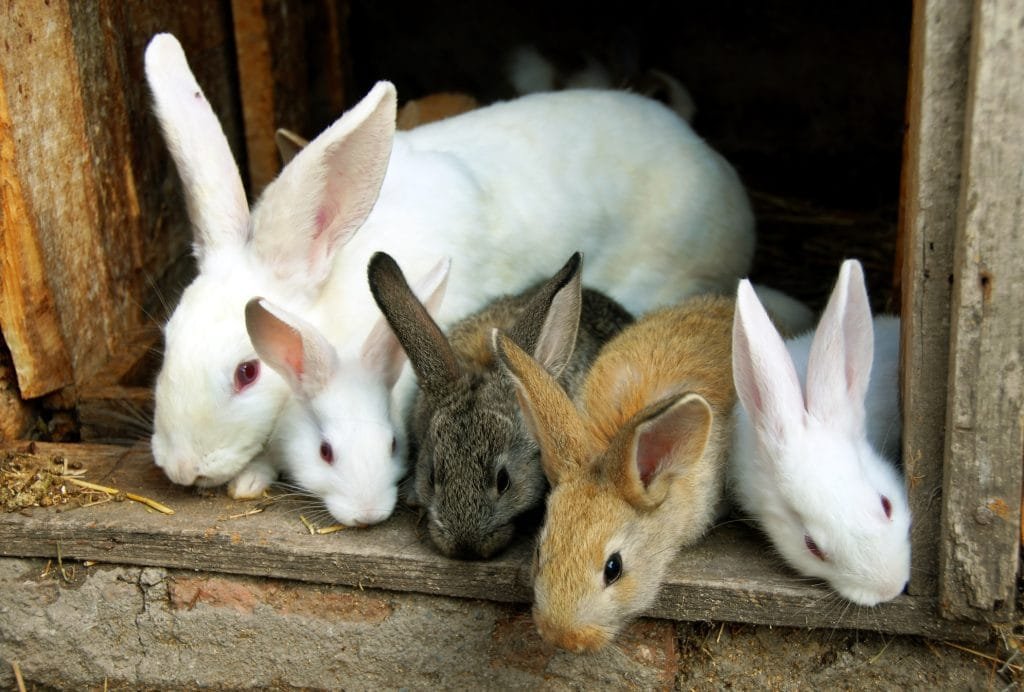This post contains affiliate links.
Breeding and raising rabbits for meat has become a viable and popular product for farmers and homesteaders. Many people feel they are easier to manage and feed than chickens and ducks and provide a higher source of income for the amount of labor and finances invested in them. One of the concerns a potential rabbit farmer may have is how much land is needed to raise rabbits.
The amount of land needed to raise rabbits is roughly 45 sq feet per rabbit. This includes hutch and exercise space. A start-up rabbit operation of 20 does and 2 bucks, you need 5445 sq ft (506 m²). This is ideal for a hutch system. Pasture-raised rabbits need 6 sq. ft of land per day to graze on.
Rabbits do not require a lot of land. They can be raised either in a hutch system or on pasture. But the amount of land needed to raise rabbits is determined by the number of rabbits you have or want to have.

What Are The Land Requirements For Hutch- System Rabbits?
Pennsylvania State University stipulates that to start with a rabbit farming operation of twenty does and two bucks, you need one-eighth of an acre (5445sq ft/506 m²). This is the minimum size operation that is effective.
Hutches should be 30 inches wide, 30 inches long, and twenty inches high. Only one mature rabbit should be housed in each hutch. If you wish to house rabbits in groups, you need to build pens that allow approximately six square feet of space for each rabbit.
Rabbit is considered healthy meat. But many wonder how it compares to chicken. Learn more in my article Is Rabbit Meat Healthier Than Chicken?
How Much Land Do You Need To Raise Rabbits On Pasture?
Each rabbit needs six square feet of pasture per day. Raising rabbits on pasture requires the pasture area to be rotated. This ensures there is adequate grazing for the rabbits. There are two approaches that can be utilized for rotational grazing.
- The farmer establishes several permanent pens and rotates the rabbits through these pens. While the rabbits are grazing in one pen, the other pens rest and the grass regrows.
- The second rotational grazing method uses a non-permanent enclosure similar to chicken tractors. A tractor consists of a portable wire enclosure that is moved daily, biweekly or weekly to allow the rabbits to graze in an area.
The advantage of rabbit tractors is that a farmer can use them to keep control of pastures and weeds. Rabbit manure fertilizes the field and improves the grazing quality. The pastures can be used by other livestock once the rabbits are moved.
- Indoor/Outdoor Cage: This bunny pen has plastic locking clips, making it easy to assemble...
- Easy Access: Easily get closer to your little pet friends to feed and groom them. This...
- Safety First: With stakes that attach this rabbit playpen to the ground, it's a safer...
Tractor-based rabbit operations allow the rabbit to graze during the day. At night they are offered rabbit pellets and additional hay.
Pasture-raised rabbits require much more land than rabbits raised in hutches. You would need 132 square feet of grazing per day for twenty does and two bucks.
The advantage of pasture-raised rabbits is that feed costs are lower, and there is no need for large buildings or facilities to contain the hutches.
Generally, pasture-raised rabbits are less prone to disease because ventilation is not an issue. Rabbit tractors allow the rabbits to move to new pastures frequently, which is advantageous for their health.
Land Requirements For Expansion In Rabbit Farming
The question of the amount of land needed to raise rabbits is tricky. A rabbit farm can grow quickly as rabbits breed prolifically. A start-up operation of forty rabbits would result in six hundred rabbits in six months.
How Fast Do Rabbits Multiply?
The gestation period of rabbits is thirty-one days, with litter sizes ranging from six to twelve kits. The doe feeds the kits for a month and then weans them. The kits will take another four to six weeks before they are ready for slaughter. So it takes 8-10 weeks from birth to slaughter for a rabbit.
When the first litter is growing during the second month, the doe will produce another litter of kits. Does can become pregnant again within a few days of giving birth.
This is not a good practice, though, and most farmers leave the doe until she has weaned the kits at four weeks before putting her back with a buck. The result is that each doe can produce up to twenty-four kits within two months, which must all be housed.
Young does experience their first heat cycle at four months and can become pregnant at this age. If you are farming rabbits, you will probably keep some young does to expand your operation. This will add to the need for more space.

Keeping Up With The Demand For Rabbit Housing Is Critical
A rabbit farming operation can rapidly expand, and you will need to have adequate land and facilities. Most rabbit farmers do not anticipate this rapid growth and get caught unaware.
The rapid expansion often results in rabbits being housed in unsuitable or inadequate living quarters. Overcrowding leads to behavioral problems such as cannibalism, fighting, and self-mutilation.
Ventilation is poor in overcrowded rabbit hutches and disease results. Rabbits die easily in these conditions, and your entire investment could be lost.
The bottom line with rabbit operations is that you need to start with more land than you need for the first batch. If you intend to expand the operation, begin building more facilities immediately.
The only alternative is to keep tight control on balancing slaughtering, mating, and growing kits. Although this sounds like a possibility, anyone who has been involved in farming can tell you that life throws you curve balls that upset the apple cart – or rabbit hutch!
The abattoir, i.e. slaughterhouse, may experience problems and be unable to assist you at the right time. You may fall ill and cannot deliver your rabbits to the abattoir. Other emergency farming chores may supersede the trip to the abattoir, and suddenly you have an overabundance of rabbits.
Commercial and agricultural wisdom dictates that if you start a rabbit farming operation, begin with more land and facilities than you initially need. It is probably prudent to have at least half an acre of land set aside for rabbits in a hutch system.
Final Thoughts
Each rabbit needs about 45 square feet for housing and exercise. If you plan on pasture raising your rabbits you will need 6 square feet of land per rabbit per day for grazing. You will need sufficient land to accommodate this. Therefore, the amount of land depends on the number of rabbits and how you intend to expand your business.

